Photographing slot canyons is truly a unique experience. Not many places on earth are as magical and photogenic as these types of canyons, with endless compositional possibilities, colors, and textures to play with.
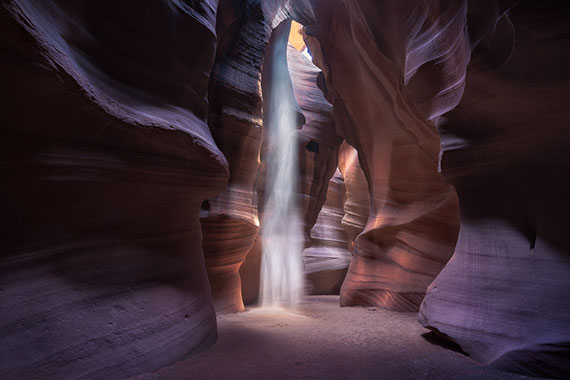
However, photographing slot canyons is not as easy as it looks; the lighting conditions, the limited space to shoot, and some other elements like dust, are factors that will test your skills.
In this slot canyon photography tutorial, I would like to highlight some specific tips about shooting in slot canyons that I’m sure will help you get back home with the best possible images.
General Tips for Slot Canyon Photography
• Although it sounds unnecessary to mention, it’s always good to remember to bring your most fundamental items for shooting slot canyons. Don’t forget to have both your DSLR / mirrorless camera and your tripod with you!
• Remember that GoPro cameras, compact cameras, will be more limited in low light conditions. As for the tripods, try to use a sturdy tripod to get your gear stable during your long exposures.
• Try not to change your lens once you enter a slot canyon. Inside these canyons, there is a tremendous amount of dust and changing your lens usually means ending up with dust in your camera sensor.
• In relation to the previous point, always carry in your pocket one or several microfiber cloths to clean the glass of your lens. You can use both alcohol cleansing wipes that are usually faster than traditional microfiber cloths. Don’t forget to keep wiping off the dust over your lens. Otherwise, in the scenes where there is a direct and strong source of light, these dust spots will ruin a large part of the image.
• If you’re shooting a slot canyon in a group, cooperation within the group is essential to move around, avoid people in your frame, and get different compositions. Remember to interact and talk with your colleagues to make the most of the experience.
Photography Gear
Having the right gear is fundamental for photographing slot canyons. Below you’ll find the essential gear for this type of photography:
Cameras – Any digital camera with interchangeable lenses is good for taking great pictures in slot canyons. However, keep in mind:
• Full-frame cameras usually capture a greater dynamic range, something crucial inside slot canyons. On certain occasions, you may have to raise the ISO, so cameras with these sensors generally perform better when shooting in low light conditions.
• APS-C cameras will be valid for shooting in this environment, but bear in mind the crop factor when choosing the type of lens that you will use inside the canyon.
Lenses – As you shouldn’t change your lens inside slot canyons, it’s recommended to use a versatile lens to change the perspective easily.
• Choose a zoom lens instead of a prime lens.
• Your best bet is a wide-angle / ultra-wide-angle zoom (Focal length between 14mm and 35 mm) rather than a medium-focal zoom.
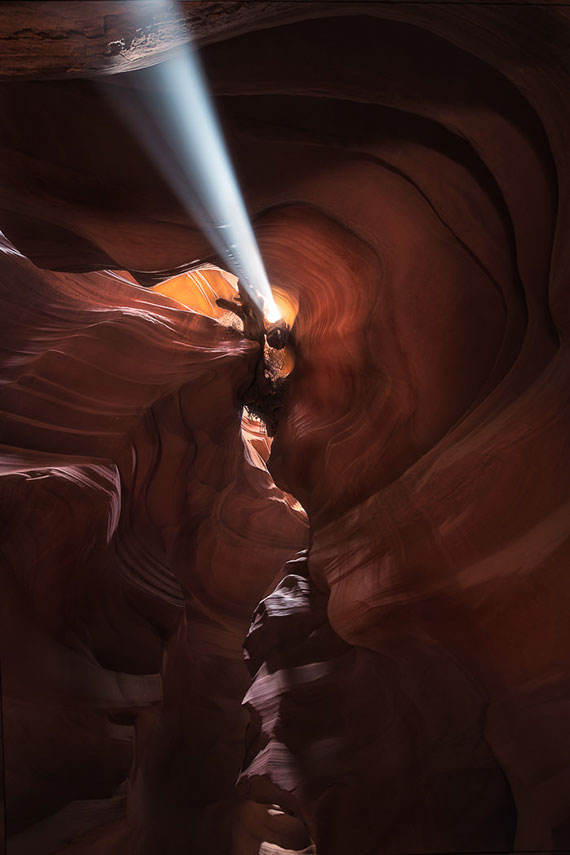
Photography taken with Nikon D800 (Full-frame) + Zoom Ultra-wide-angle 14-24 2’8
Tripod – I like taking a versatile tripod for shooting slot canyons. Some areas are very narrow, and having greater mobility is very important. The tripod must be sturdy to avoid any camera shakiness.
Lens Filters – Given the light conditions of the canyon it’s not necessary to use filters. There are certain scenes that will be high contrast between the lights and shadows where a graduated filter might seem useful, but remember that the space and dust of the canyon makes everything more challenging, so I don’t recommend using lens filters.
Batteries – Take one or two extra batteries in case you need them.
Remote trigger – When using a tripod, you can use a remote trigger to avoid vibrations. Following the need for mobility and quick action I recommend using the camera’s internal trigger in the 2-second mode, although this will depend on your personal preferences.
Photography Tips Inside Slot Canyons
Once you have the right gear, it’s important to know the basics for photographing slot canyons. Some of the most important are:
Composition
• Open your eyes and stop to see and think for a few seconds what elements you can photograph as you advance throughout the canyon. Take your time to look around for different compositions before you start shooting.
• Although there are some spots where either a vertical or horizontal composition is better, others can be photographed from both perspectives. If you have any doubt, try to shoot in both ways so you can choose to edit the one you like the most later.
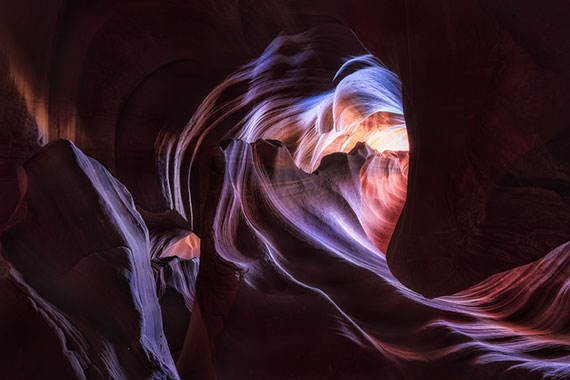
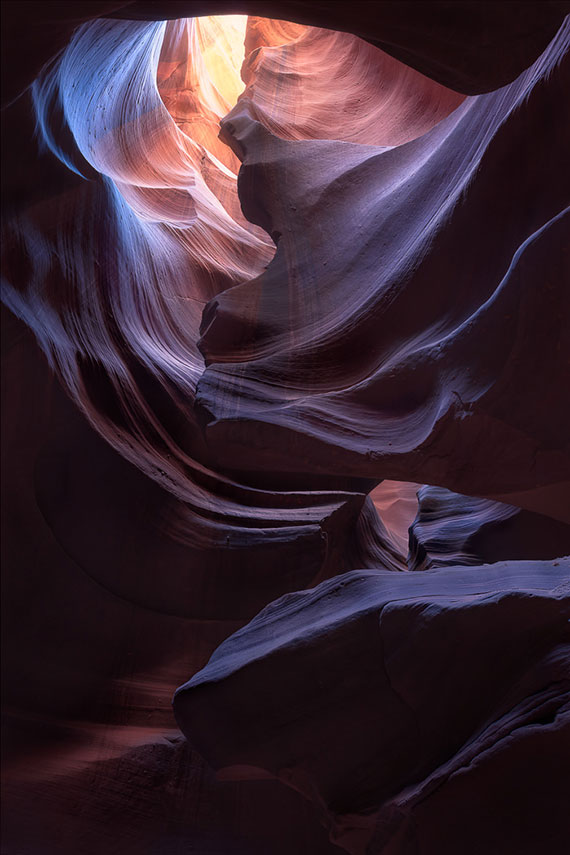
• Slot Canyons are the perfect place to unleash your creativity, so also try to risk and shoot different compositions
Focus
Slot canyons are wide enough to focus at the hyperfocal distance and capture the entire scene with enough sharpness.
You can focus at the hyperfocal distance before entering the canyon and, once inside, don’t forget to set the focus on manual mode. *Remember that if you change your focal length, the hyperfocal distance will vary and you may have to readjust the focus.
Settings
Using the right settings will be essential for quality shots. Each slot canyon is different in terms of light, but below, you can check out some of the most common parameters as a reference.
ISO – Despite the darkness in certain areas of slot canyons, when using a tripod, you won’t find any problems using a low ISO. Depending on the circumstance, ISO 100 to ISO 400 will probably do the trick. In my case, ISO 200 is my go-to for slot canyons.
Aperture – You can use apertures between f/8 and f/11 with the intent of creating balance between speed and luminosity. If you’re shooting closer to one of the walls, you can close down your aperture even up to f/16, and increase the time to get a greater depth of field. An aperture of f/8 is a good starting point.
Shutter Speed – This is the most important setting to consider. Depending on the previous settings and the light conditions of each scene, you can set the shutter speed from 1/25 of a second to 3 seconds. Below you can see some examples:
• In general scenes where there isn’t any source of direct light in the composition, you can set a shutter speed between 1.6 and 3 seconds
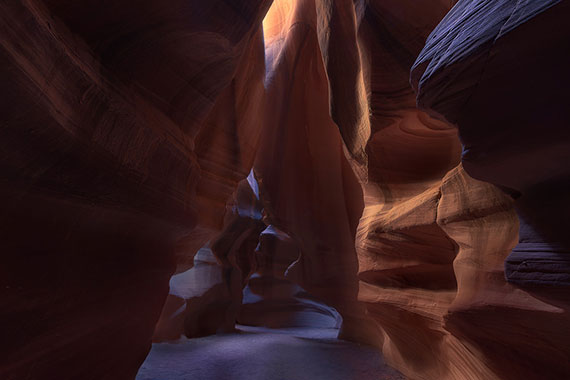
ISO 200, f/8.0, 1.6-second exposure.
• In general scenes where there is also a strong source of light, you can take more shots with a shorter shutter speed to do bracketing. I explain bracketing in a later part of this article.
• In slot canyons where there are halos and you want to capture all the details, you’ll have to set short times around 1/25 second. In these cases, you can also bracket your images to recover the shadows in the rest of the scene.
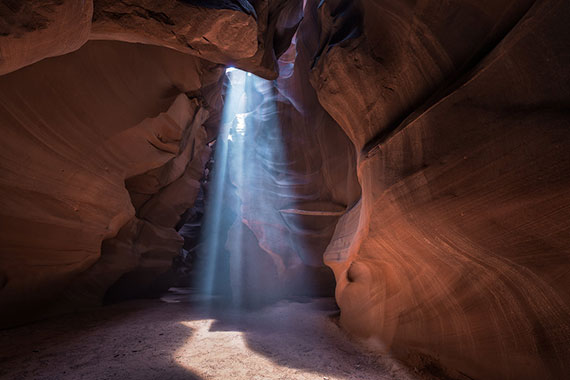
ISO 200, f/8.0, 1/40-second exposure.
• If you create sand falls in your slot canyon, you can set an exposure between 2.5 and 4 seconds to capture the motion.
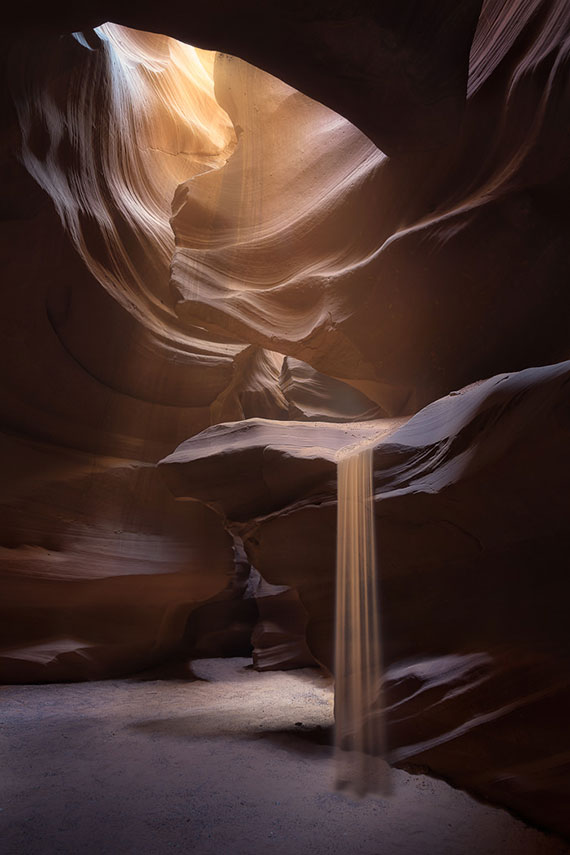
ISO 200, f/8.0, 2.5-second exposure.
Other Photography Techniques
When you want to shoot slot canyons, there are also other techniques that you can use to make the most of your gear and the scene:
Bracketing
The dynamic range inside slot canyons can be huge, with some areas of deep shadows and strong lights at the same time.
In these cases, it’s impossible to get a photo with all the lights and shadows correctly exposed in one shot.
To do bracketing:
• If your camera has this function, select the number of shots depending on the strength of the light. If the highlights are powerful, do not hesitate to set an extreme bracketing of even 5 or 7 shots.
• If your camera does not have this function, I would suggest exposing to the area with the strongest light in the scene, and from there start taking shots lowering the exposure little by little until you can capture the details in the shadows.
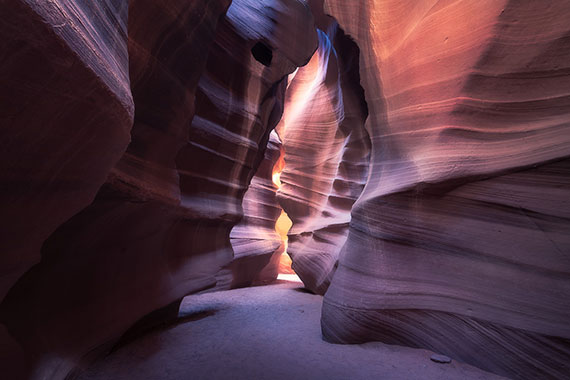
3-shot bracketing to cover the entire dynamic range.
Focus Stacking
Another technique to use in slot canyons is focus stacking. Through this technique, you can get closer to the walls of the canyon and get original compositions.
To do focus stacking:
• Set up your tripod, set the shutter speed, and open the aperture to the maximum allowed by your lens.
• Next, close the aperture to a high f-stop, such as f/16, and select the closest area to the lens.
• Focus either automatically or manually and shoot.
• Then continue to repeat this process in further areas of the scene until all the elements are sharp and on focus.
• Merge the different shots on Photoshop, and you will have an image with the greatest sharpness and definition.
• For this technique, I consider it very helpful to use the Live View mode and to focus automatically on different points of the scene.
Editing and Processing
Finally, don’t forget to edit your images according to your taste.
The editing and processing that you want to make in your images will depend on your personal preferences. Still, some tips that work well in general are to avoid over saturating the images, and follow a workflow that can extract all the details inside the canyon, both in the highlights and the shadows.
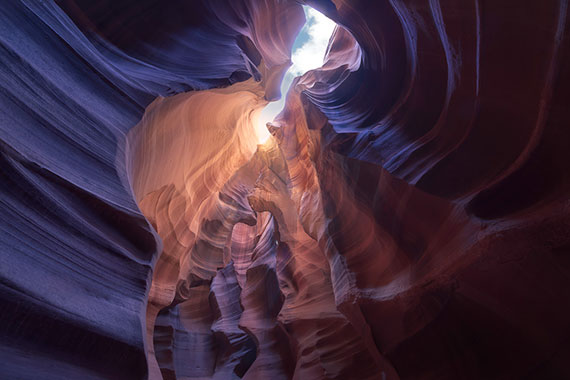
Conclusion
As you can see, photographing slot canyons is not as hard as it seems. All you need is to consider the right equipment, some basic settings, and the most important thing – enjoy the opportunity of shooting inside one of the most breathtaking natural wonders on our planet!
I hope this guide helps you in the future and you can shoot stunning photographs inside slot canyons.
Feel free to leave any questions in the comments.
About the author:
Dan Zafra is a passionate travel photographer and co-founder of the travel photography and photo tours website Capture the Atlas. To see more of his work, visit Capture the Atlas.
Go to full article: Slot Canyon Photography Tutorial
What are your thoughts on this article? Join the discussion on Facebook
PictureCorrect subscribers can also learn more today with our #1 bestseller: The Photography Tutorial eBook
The post Slot Canyon Photography Tutorial appeared first on PictureCorrect.
from PictureCorrect https://ift.tt/2PIkEFP
via IFTTT






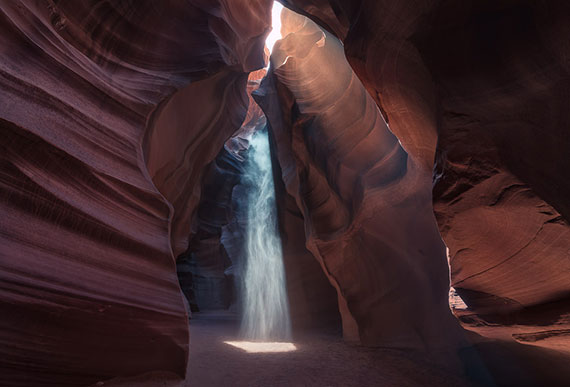
0 kommenttia:
Lähetä kommentti